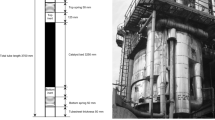Abstract
A moving bed reactor (MBR) is one of the most innovative reactors that are commonly used in industry nowadays. However, the modeling and optimization of the reactor have been rarely performed at conceptual design stage due to its complexity of design, and it has resulted in increased capital and operating costs of the overall chemical processes. In this work, advanced strategies were introduced to model an MBR and its regenerator mathematically, incorporating catalyst deactivation, such as coke formation. Various reactor designs and operating parameters of the MBR were optimized to increase the overall reactor performance, such as conversion or selectivity of the main products across the reactor operating period. These optimization parameters include: (1) reactant flow inside a reactor, (2) various networks of MBRs, (3) temperature of the feed stream, (4) intermediate heating or cooling duties, (5) residence time of the catalyst or velocity of catalyst flow, and (6) flow rate of the fresh make-up catalyst. The propane dehydrogenation process was used as a case study, and the results showed the possibility of significant increase of reactor performance through optimization of the above parameters. For optimization, the simulated annealing (SA) algorithm was incorporated into the reactor modeling. This approach can be easily applied to other reaction processes in industry.
Similar content being viewed by others
References
R.J. Schaefer, D. Vortmeyer and C.C. Watson, Chem. Eng. Sci., 29(1), 119 (1974).
C. M. Marb and D. Vortmeyer, Chem. Eng. Sci., 43(4), 811 (1988).
T. N. Haynes and H. S. Caram, Chem. Eng. Sci., 49(24, II), 5465 (1994).
E. H. P. Wolff, Chem. Eng. Sci., 49(24, II), 5427 (1994).
J. Fricke and H. Schmidt-Traub, Chem. Eng. Process., 42(3), 237 (2003).
Z. Mu, J. Wang, T. Wang and Y. Jin, Chem. Eng. Process., 42(5), 409 (2003).
S. Sahebdelfara, P. M. Bijani, M. Saeedizada, F.T. Zangeneha and K. Ganji, Appl. Catal. A-Gen., 395, 107 (2011).
Z. Szwast and S. Sieniutycz, Chem. Eng. J., 103(1-3), 45 (2004).
H. S. Fogler and M. N. Gurmen, http://www.engin.umich.edu/ ~cre/course/lectures/ten/index.htm.
M. Larsson, Coke on supported palladium and platinum catalysts, PhD Thesis, Chalmers University of Technology (1997).
B. Jiang, X. Feng, L. Yan, Y. Jiang, Z. Liao, J. Wang and Y. Yang, Ind. Eng. Chem. Res., 53, 4623 (2004).
D. K. Leea, H. Baek and W. L. Yoon, Int. J. Hydrogen Energy, 31, 649 (2006).
Y. S. Cho and B. Joseph, Ind. Eng. Chem. Process Des. Dev., 20, 314 (1981).
E. Aylón, A. Fernández-Colino, M.V. Navarro, R. Murillo, T. García and A. M. Mastral, Ind. Eng. Chem. Res., 47, 4029 (2008).
M. Kawase, T.B. Suzuki, K. Inoue, K. Yoshimoto and K. Hashimoto, Chem. Eng. Sci., 51(11), 2971 (1996).
J. Xu, Y. Liu, G. Xu, W. Yu and A.K. Ray, AIChE J., 59(12), 4705 (2013).
N. S. Graça, L. S. Pais, V.M.T.M. Silva and A.E. Rodrigues, Chem. Eng. J., 207-208, 504 (2012).
A.S. Kurup, H. J. Subramani, K. Hidajat and A.K. Ray, Chem. Eng. J., 108, 19 (2005).
W. Yu, K. Hidajat and A. K. Ray, Ind. Eng. Chem. Res., 42, 6743 (2003).
J. Gascón, C. Téllez, J. Herguido and M. Menéndez, Appl. Catal. A-Gen., 248(1-2), 105 (2003).
A. Sadana and L. K. Doraiswamy, J. Catal., 23(2), 147 (1971).
T. Rzesnitzek, H. Mullerschon, F. C. Gunther and M. Wozniak, Infotag “Nichtlineare Optimierung und stochastische Analysen mit LSOPT,” Stuttgart.
S. Hwang and R. Smith, Korean J. Chem. Eng., 29(1), 25 (2012).
A. R. Dozier, Cross-flow reactor, US Patent, 4,108,106 (1978).
J.M. Lee, Cross-flow, fixed-bed catalytic reactor, US Patent, 5,520,891 (1994).
J. D. Snyder and B. Subramaniam, Chem. Eng. Sci., 53(4), 727 (1998).
M.G. Hunter and K.W. Goebel, Two-stage hydroprocessing reaction scheme with series recycle gas flow, US Patent, 5,958,218 (1999).
H. T. Delbridge and D. C. Dyson, AIChE J., 19(5), 952 (1973).
Author information
Authors and Affiliations
Corresponding author
Rights and permissions
About this article
Cite this article
Ghodasara, K., Hwang, S. & Smith, R. Catalytic propane dehydrogenation: Advanced strategies for the analysis and design of moving bed reactors. Korean J. Chem. Eng. 32, 2169–2180 (2015). https://doi.org/10.1007/s11814-015-0050-x
Received:
Accepted:
Published:
Issue Date:
DOI: https://doi.org/10.1007/s11814-015-0050-x




